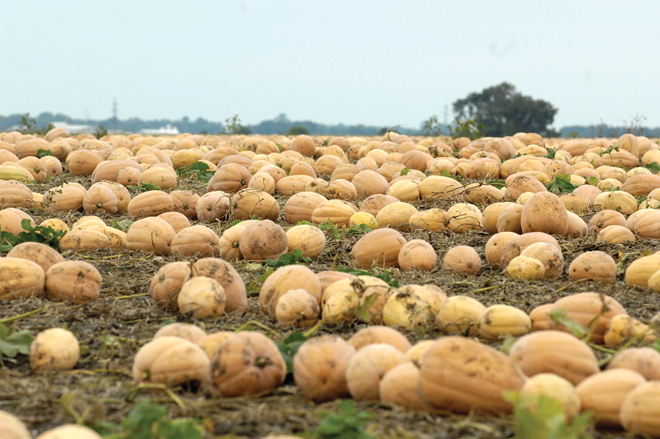Apr 26, 2018Illinois growers produce holiday standby at ‘pumpkin capital’
Morton, Illinois is the self-proclaimed “Pumpkin Capital of the World,” and it’s hard to argue the town’s right to that title.
Much of the surrounding countryside in north central Illinois is dedicated to growing pumpkins for canning by Libby’s, the standby for home-baked holiday pies, that’s owned by Nestlé USA. At press time, the company was in the process of contracting with growers for the 2018 season, but roughly 100 growers each year plant several thousand acres of the pumpkins within a 50-mile radius of Morton, said Nestlé USA spokeswoman Allison Kolodziej Baker. More than 75 percent of the canned pumpkin in the U.S. runs through the Nestlé canning facility in Morton.
How they’re grown
The reason pumpkins thrive in north central Illinois is in the land, which has sandy, fertile soils. The land is irrigated but usually has a hot, relatively dry summer, Baker said.
Grower Mark Berg has been farming pumpkins for the Libby’s brand for more than 25 years.
“Each year presents its challenges,” he said in a video released by the company.
Pest threats, and disease threats, including downy mildew, powdery mildew and phytophthora, are concerns.
“In 2017, pest pressure was average; powdery mildew was a challenge,” Baker said. “Overall, we had to apply fewer treatments in 2017 than in the previous year.
“We had a warm, dry summer in 2017, which gave us a strong crop early in the season. Unfortunately, the harvest ended a bit early due to a frost in late October. Once frost hits, and weather becomes chilled, the quality of the remaining fruit in the fields begins to decline. When that happens, we end the harvest.”
Harvest and production kicks off in August and runs through late October/early November in a typical year, Baker said.
With so many pumpkins to harvest, the growers are a little past relying on simply strong backs and a flatbed trailer. Specialized equipment designed by Nestlé loads the pumpkins into semi-truck-trailers; video released by Nestle show machines pushing the pumpkins into rows, scooping them off the ground and then dumping them into a hydraulic trailer, which then dumps them into a semi-trailer.
While the last two years have been reasonably dry, growers have had difficult years within recent memory.
“We faced a shortage in 2009 and again in 2015 due to heavy rains in Illinois during the growing season,” Baker said. “While we always hope for a warm, relatively dry summer, we’re at the mercy of Mother Nature, like any other agricultural product.”
A pumpkin of a different color
Processing pumpkins are different than their cousins, jack-o’-lanterns and ornamentals, said Nathan Johanning, an Extension educator for the University of Illinois Extension.
While both are members of the Cucurbita genus, jack-o’-lantern pumpkins are Cucurbita pepo while most processing pumpkins are Cucurbita moschata. The processing pumpkins, he said, have a tan, rather than orange, color, and a dark orange flesh that’s sweeter than their cousins’.
Libby’s, in particular, harvests a special strain of the Dickinson pumpkin, which Baker said is “known for its delicious taste, creamy texture and pleasing orange color.”
“Our Dickinson pumpkins don’t look like the traditional carving pumpkins, but that’s a good thing because they are much tastier,” she said.
How they’re sold
Consumer obsession with “pumpkin spice” flavor has grown in recent years, and while doubtless many “pumpkin spice” products have little connection to the actual vegetables, Libby’s has done some marketing work to capitalize on the craze.
“At Libby’s, we know that people love their pumpkin spice items in the fall, so we even developed our own pumpkin spice latte, which uses our canned pumpkin,” Baker said. “On (Nestlé ‘s) website (www.VeryBestBaking.com), we still see quite a bit of interest in our traditional, family-favorite pumpkin recipes.”
Pumpkin can also be used as a substitute for eggs, oil and butter in many recipes, and the website offers ideas for using canned pumpkin to reduce fat and cholesterol while adding flavor and fiber to favorite foods.
Canned pumpkin remains high in demand from consumers.
“We don’t share specifics on production, but I can provide a fun fact that illustrates the sheer quantity of canned pumpkin we produce each year,” Baker said. “If every can of pumpkin produced by Libby’s in an average year was made into eight-inch pies, the pies would stretch from New York to L.A. more than five times.”
– Stephen Kloosterman, VGN Assistant Editor
Photo: Libby’s/Nestlé USA
















